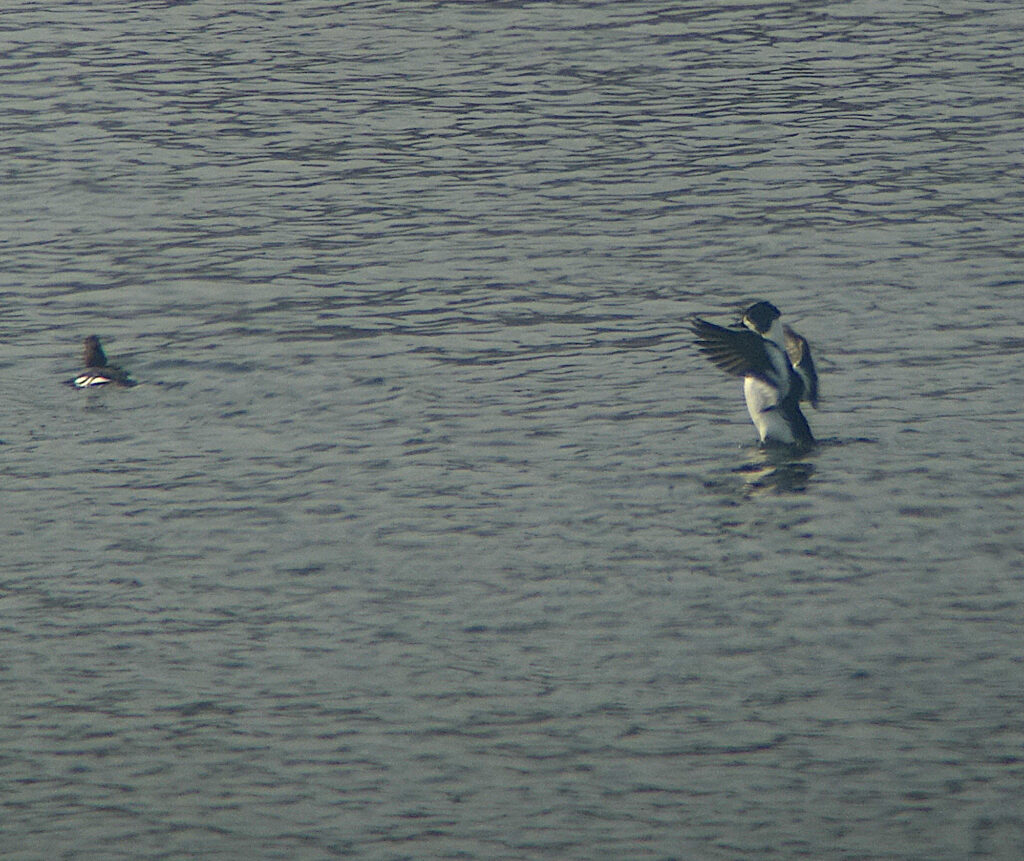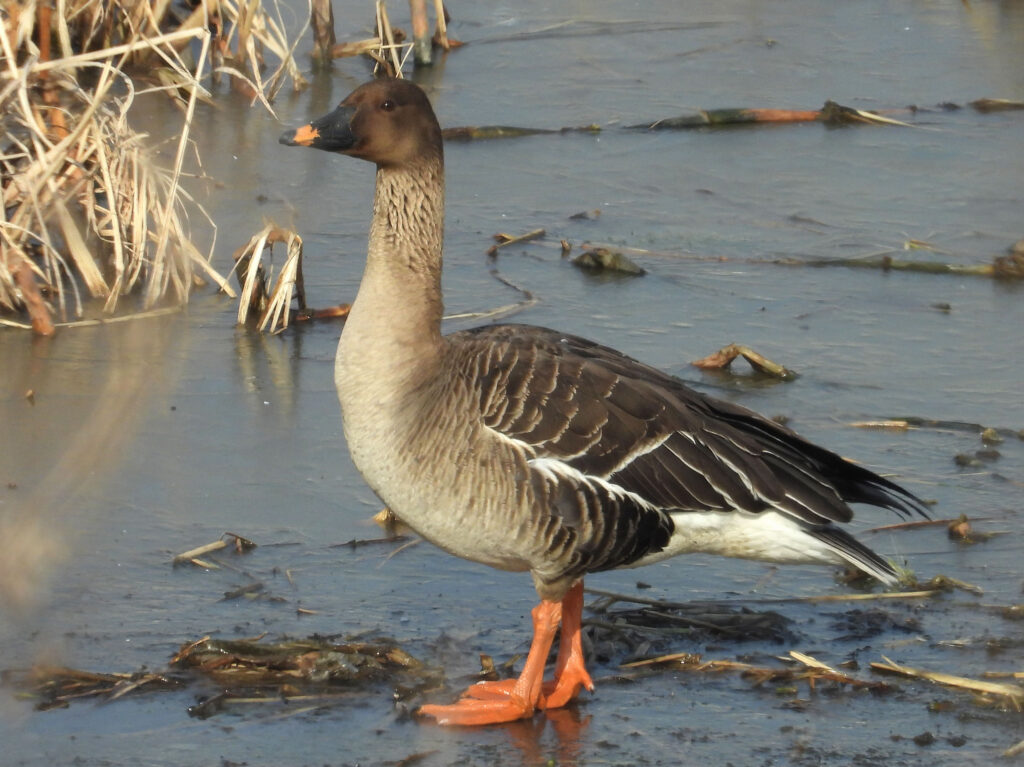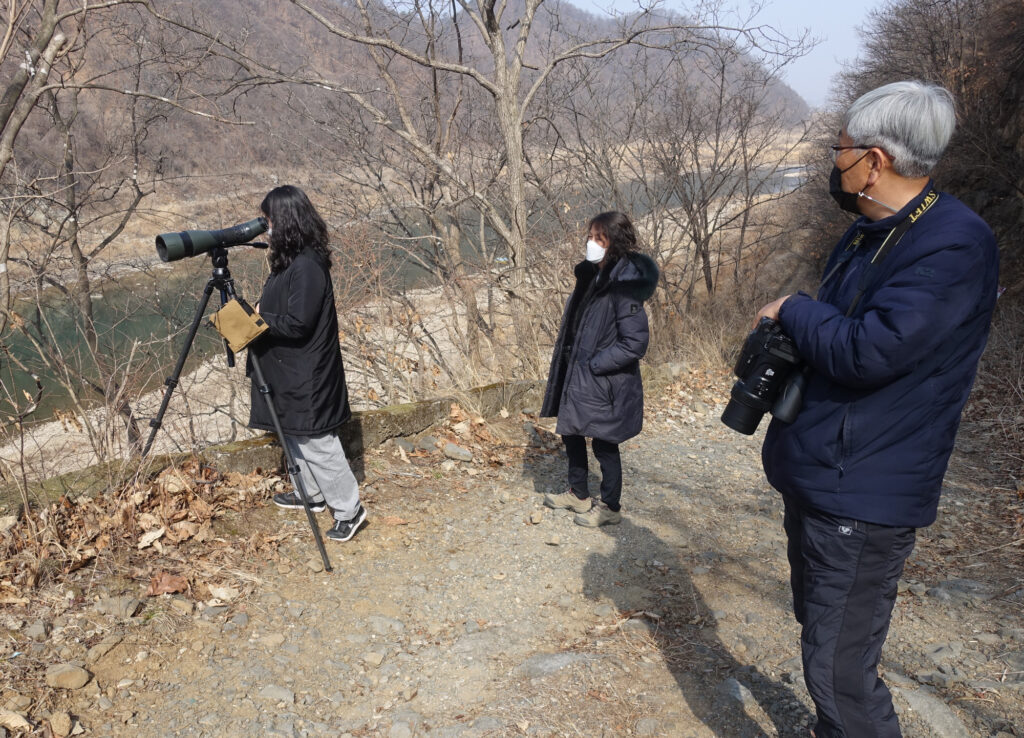Nial Moores, Baek Seung-Kwang, Lee Su-Young, Jang Ryang, Lee Su-Jin and Kim Hi-Song.
The following are a few highlights and insights from research conducted by Birds Korea under contract from Yeoncheon County in the internationally important Core and Buffer Zones of the Yeoncheon Imjin River Biosphere Reserve in the first three weeks of March. In all, we logged 93 bird species during this period; unfortunately, this was the same period in which two White-naped Cranes were apparently found dead, infected by Poultry Flu. Remarkably, the birds were found in or very close to fields recently “fertilized” by animal waste, in sufficiently high concentrations to attract up to 70 foraging Cinereous Vulture in late February.

March 1st: First adult Scaly-sided Merganser found since mid-December, indicating the start of northward migration of this species through the Biosphere Reserve (and presumably elsewhere in the ROK).
March 4th: Our first full waterbird survey found almost 1% of the world population of the globally Endangered Scaly-sided Merganser, including 11 adult males; the continuing hybrid Smew x Common Goldeneye (first seen in mid-February); at least 18 Baikal Teal; a single Common Crane in with still large numbers of White-naped and Red-crowned Cranes – many of which were in part of the CCZ designated this month as a Crane Habitat National Natural Monument (thanks in large part to the tireless efforts of BSK!!); single Chinese Grey Shrike and Common Starling – both likely to be early spring migrants; and a flock of about 30 Chinese Grosbeak, many in song.




In addition to the personal first Little Ringed Plovers of the spring, we also noted the start of active display flights by Long-billed Plovers. Our surveys have so far found 20 or more territories of this Nationally Vulnerable species within the Biosphere Reserve – many of them, however, threatened by cars driving into the river and “free camping” on shingle banks used for nesting. Conservation of biodiversity is a primary function of Core Zones of Biosphere Reserves, as outlined clearly by UNESCO (2021). Disturbance and in some cases destruction of nesting plovers by vehicles is clearly incompatible with this guidance.
March 6th: Plenty of northward migration again in evidence, with flocks of Rook and a few raptors flying north. Our efforts to check an internationally important concentration of Greater White-fronted Geese (2,800 and counting) were happily interrupted by a text message, that Yeoncheon Birds Koreans Jang Ryang, Lee Su-Jin and Kim Hi-Song had just found a Solitary Snipe during their survey in a different part of Yeoncheon (with their survey kindly funded by the Hanns Seidel Foundation Korea Office). It took us some time to find the bird, which was feeding voraciously at close range for long periods, only interrupted by taking short naps in the warm spring sunshine: beautiful! A Short-eared Owl in the evening was also a personal first here (for NM at least).



March 7th: Substantial numbers of geese were on the move, with more than 1,200 Tundra Bean seen going north in only 80 minutes. Landbirds included several small flocks of Rustic Bunting, a half-dozen Siberian Accentor, and the only Eurasian Bullfinch and Pallas’s Rosefinch of our survey so far this month (this was a wretchedly poor winter for seeing small landbirds here, probably because of the lack of snow cover in the mountains). Deeply upsetting was watching a flock of 17 Scaly-sided Merganser flushed by a cyclist riding down a newly-opened track along the river. Most of these birds were flushed again an hour later from a site 3 km to the north by a low-flying helicopter. This within the Core Zone of a designated Biosphere Reserve, described in UNESCO’s (2021) guidelines as an “example of what a specific ecosystem would look like in the absence of – or with minimal – human interference…”

March 8th: Our first Common Sandpiper (followed a day later by another in a different river) and our first Northern Lapwings of the spring; a further increase in Scaly-sided Merganser; at least three Nationally Critically Endangered Hill Pigeon; and the personal first displaying Falcated Duck of the spring, with two males using their elongated “falcations” to make and “hold” an inflated dark frame surrounding the strikingly contrasting pale pattern to their rears. These contrasts seemed to attract the gaze of an otherwise uninterested looking female.



March 10th: Another day of obvious migration through this inland area started with a possible Red-breasted Flycatcher calling from tangled vegetation above a small, recently-thawed pond used by 47 Taiga Bean Geese, followed soon after by the personal first modesta Great Egret of the spring, and at least 7 Mandarin Duck. Highlight under clear blue skies was a mixed group of Red-crowned and White-naped Cranes (former being playfully harrassed by a Korean Water Deer) and three geese taxa out on a still-frozen section of the river.




March 11th: Only a few hours in the field, set aside to show Yeoncheon County staff Scaly-sided Mergansers and their habitat. At just two stops we found almost 2% of the world population: the highest count of the spring to date.

March 12th: Ahead of a rain system, obvious inland migration up the meandering Imjin River included two adult Black-tailed Gull, 12 Mongolian Gull and four Black-headed Gulls moving upstream in under an hour; and a flock of 22 Eurasian Wigeon flying upstream, then downstream, then upstream again – being relocated 90 minutes later 5km (overland) to 10km (along the river) further upstream. This stretch of the river is about 50km upstream to the northeast from Yudo and the expansive Han-Imjin Estuary. Remarkably, for waterbirds trying to cross the Korean Peninsula here, to migrate towards the Russian Far East and beyond, the waters of Wonsan Bay (on the east coast of the DPRK) are only 145km directly northeast from this point, mostly across open plains; while due east, the sea is at least 170km away, behind a high forested mountain range.
March 21st: Still some Scaly-sided Mergansers remain – indicating the high importance of the Yeoncheon Imjin River Biosphere Reserve to this species – as do some Mandarin Duck and Long-billed Plovers… Of note too, the day also included the submission of a 19 page report to the County detailing conservation solutions to imminent threats to Scaly habitat along 3.5km of Core and Buffer Zones (shared also with the EAAFP Scaly-sided Merganser Task Force and associated experts, and available to Birds Korea members by request); a call with a County Official to help explain our report; and a mail to the County Mayor, who led the remarkable process of designation of the whole County as a Biosphere Reserve in 2019, in order to help Yeoncheon County’s progress toward genuinely sustainable development. Birds Korea is delighted to be able to help support the County and its people toward that vital goal with honest data and “best information”.


